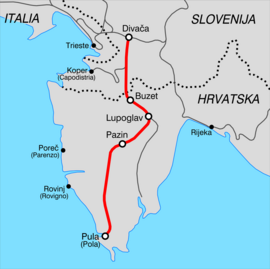Divača – Pula railway line
| Divača – Pula | |||||||||||||||||||||||||||||||||||||||||||||||||||||||||||||||||||||||||||||||||||||||||||||||||||||||||||||||||||||||||||||||||||||||||||||||||||||||||||||||||||||||||||||
|---|---|---|---|---|---|---|---|---|---|---|---|---|---|---|---|---|---|---|---|---|---|---|---|---|---|---|---|---|---|---|---|---|---|---|---|---|---|---|---|---|---|---|---|---|---|---|---|---|---|---|---|---|---|---|---|---|---|---|---|---|---|---|---|---|---|---|---|---|---|---|---|---|---|---|---|---|---|---|---|---|---|---|---|---|---|---|---|---|---|---|---|---|---|---|---|---|---|---|---|---|---|---|---|---|---|---|---|---|---|---|---|---|---|---|---|---|---|---|---|---|---|---|---|---|---|---|---|---|---|---|---|---|---|---|---|---|---|---|---|---|---|---|---|---|---|---|---|---|---|---|---|---|---|---|---|---|---|---|---|---|---|---|---|---|---|---|---|---|---|---|---|---|---|
| Route length: | 122 km | ||||||||||||||||||||||||||||||||||||||||||||||||||||||||||||||||||||||||||||||||||||||||||||||||||||||||||||||||||||||||||||||||||||||||||||||||||||||||||||||||||||||||||||
| Gauge : | 1435 mm ( standard gauge ) | ||||||||||||||||||||||||||||||||||||||||||||||||||||||||||||||||||||||||||||||||||||||||||||||||||||||||||||||||||||||||||||||||||||||||||||||||||||||||||||||||||||||||||||
|
|||||||||||||||||||||||||||||||||||||||||||||||||||||||||||||||||||||||||||||||||||||||||||||||||||||||||||||||||||||||||||||||||||||||||||||||||||||||||||||||||||||||||||||
The Divača – Pula railway opens up the Istrian peninsula in a north-south direction and connects the port city of Pula to the European railway network. It runs in Slovenia and Croatia .
Technical parameters
The route is 122 km long, single-track , steep inclines and built in standard gauge . It is only electrified in its northern section between Divača and Prešnica . The overhead line continues from there over the Prešnica – Koper railway line .
history
The Divača – Pula line was planned by the Istrian State Railways from 1873 and opened on September 20, 1876. The construction management was Gustav Gerstel . The route was then in Austria-Hungary . The original station names therefore partly differed from today's names. In the course of the expansion from Pola ( Pula ) to the main Austrian naval port, the route was of great strategic military importance. Pola was only connected to the rest of the Austrian-Hungarian railway network with this railway line. As early as 1880, the Istrian State Railroad was incorporated into the Imperial and Royal State Railways. Some stations were only opened later.
After the break-up of Austria-Hungary, the region of Istria and with it the railway line came to the Kingdom of Italy . The rail traffic was led by the Ferrovie dello Stato Italiane (FS). After the end of the Second World War , Yugoslavia received the Istrian peninsula, and the Yugoslav State Railways (JŽ) now operated the route. During this time it served an important bathing traffic to the Istrian tourist places. President Josip Broz Tito also used the route several times with his Plavi voz special train , as he set off from Istria to the presidential island of Brijuni .
After the fall of Yugoslavia, most of the route fell to Croatia, but as an island operation isolated from the Croatian railway network , and was only accessible via Slovenian territory. A small part of the route is in Slovenia. Continuous passenger traffic today takes place on the entire route only in the summer months. Freight traffic has not existed for a few years. In Croatia today, the route mainly meets local traffic needs. Around five pairs of trains run daily, which are driven by older-style diesel multiple units.
Planning
There have been numerous projects to connect the Istrian railway with other routes. After the breakup of Yugoslavia, the plan was pursued for some time to connect the line to the railway in Rijeka .
Branch lines
The railway has or had the following branches off:
- The long disused railway line Trieste – Hrpelje-Kozina, which connects Istria with both the regional capital Trieste and the network of the Imperial and Royal State Railways. Today the route lies on Italian and Slovenian territory.
- The Koperbahn , which is currently used intensively and is planned for further expansion, on Slovenian territory ,
- in Croatia the Lupoglav – Raša railway line , which is structurally still present but without traffic and
- also in Croatia the Kanfanar – Rovinj railway line , which has been closed for decades.
literature
in alphabetical order by authors / editors
- Railway Atlas Italy and Slovenia . Schweers + Wall , Aachen 2010. ISBN 978-3-89494-129-1
- Illustrated guide to the kk Österr. State railways for the lines Trieste – Pola, Canfanaro – Rovigno, Herpelje-Kozina – Divaca, Trieste – Parenzo, Monfalone – Cervignano (–Grado), Görz – Haidenschaft. Sea steamship: Trieste – Pola – Fiume (–Abbazia). Trieste – Venice. Newly edited using official data from the Imperial and Royal State Railway Administration . Steyrermühl 1896.
- Egbert Peinhopf: Railways in Istria - then and now . bahnmedien.at , Vienna 2017, ISBN 978-3-9503921-8-0
- Egbert Peinhopf: Railway impressions from Istria . bahnmedien.at, Vienna 2017, ISBN 978-3-903177-05-5
- Joachim Piephans: Rail joint close to the border . Berlin 2007. ISBN 978-3-935909-00-6
